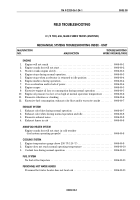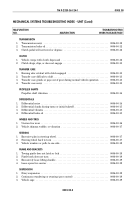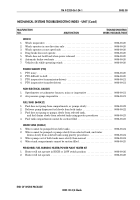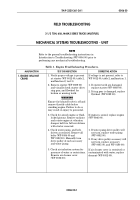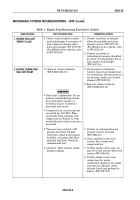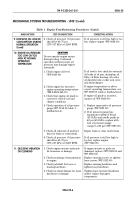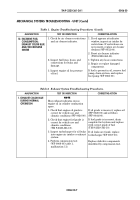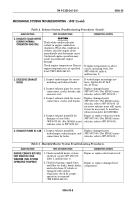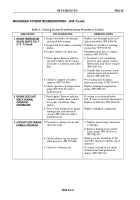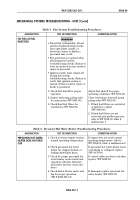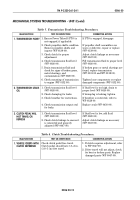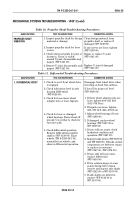TM-9-2320-361-24-1 - Page 102 of 1176
TM 9-2320-361-24-1
0006 00
0006 00-6
MECHANICAL SYSTEMS TROUBLESHOOTING - UNIT (Contd)
MALFUNCTION
TEST OR INSPECTION
CORRECTIVE ACTION
9. EXCESSIVE OIL LOSS OR
CONSUMPTION DURING
NORMAL OPERATION
(Contd)
6. Check oil pressure. Oil pressure
should be 40–75 psi
(275–517 kPa) at 2,600 RPM.
If oil pressure is still too high or too
low, replace engine (WP 0046 00).
10. ENGINE OIL PRESSURE
TOO LOW OR TOO
HIGH AT NORMAL
OPERATION
TEMPERATURE
CAUTION
Do not operate engine except
during testing. Continued
operation without proper oil
pressure may damage engine
internally.
1. Check engine oil level
(WP 0020 00).
2. Check engine for excessive
engine operating temperature
(TM 9-2320-361-10).
3. Check that engine oil grade is
correct for vehicle use and
climate conditions.
4. Check operation of oil pressure
gauge (WP 0014 00, table 1,
malfunction 4).
5. Check all external oil and fuel
lines for leaks or restrictions.
6. Check oil pressure. Oil pressure
should be 40–75 psi
(275–517 kPa) at 2,600 RPM.
If oil level is low, check for external
oil leaks at oil pan, drainplug, oil
filter, oil filter housing, oil cooler,
oil dipstick tube, rocker arm cover,
and turbocharger.
If engine temperature is above
correct operating temperature, see
WP 0006 00, table 4, malfunction 1.
If engine oil grade is incorrect,
replace oil (WP 0020 00).
1. Replace inoperative oil pressure
gauge (WP 0095 00).
2. If oil pressure gauge has
maximum reading of 60 psi
(413 kPa) and needle peaks at
60 psi (413 kPa), replace with
new oil pressure gauge
(range 0–120 psi) (WP 0095 00).
Repair leaks or clear restrictions.
If oil pressure is still too high or
too low, replace engine
(WP 0046 00).
11. EXCESSIVE VIBRATION
OR CLUNKING
1. Check engine mounts and pads
for looseness or damage.
2. Check mounting of transmission
to engine.
3. Check jackshaft for loose or
missing hardware.
4. Check torsionel damper for loose
hardware or damage.
If engine mounts or pads are
damaged, replace (WP 0024 00 and
WP 0025 00).
Replace missing screws or tighten
loose screws (WP 0132 00).
Replace missing hardware and
tighten loose hardware.
Tighten loose torsionel hardware
and/or replace damaged
components.
Table 1. Engine Troubleshooting Procedures (Contd).
Back to Top


